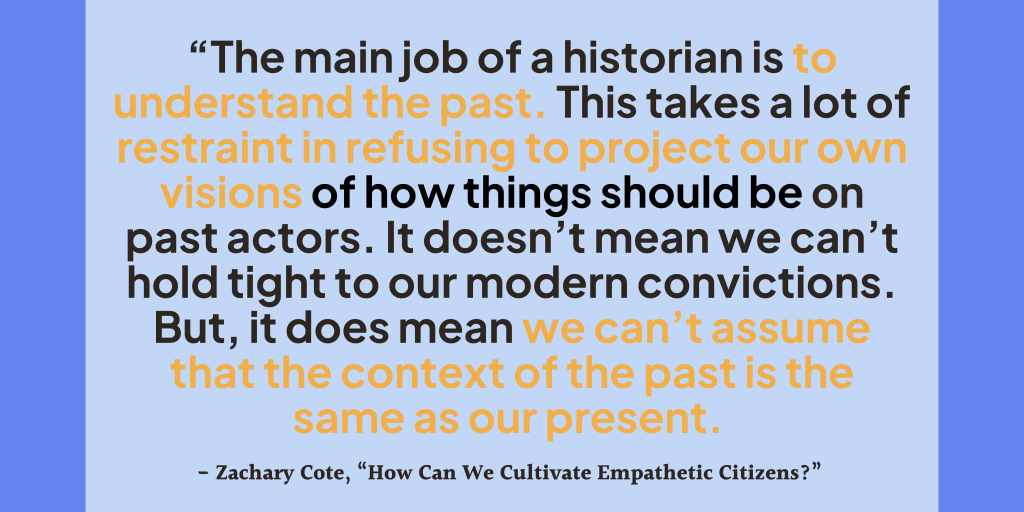
(Read on for free resources!)
We may earn revenue from the products available on this page and participate in affiliate programs.
In recent years, “empathy” has generated buzz‒and not always in a good way. As some, such as Paul Bloom make a case “Against Empathy,” historical empathy has gotten lumped in with the subsequent criticism.
At Thinking Nation, we see historical empathy is an essential tool in the historian’s toolbelt. But what do we actually mean by “historical empathy?”

Our Definition

Historical Empathy – Thinking historically means seeking to understand the past on its own terms by considering the context and perspectives of the era. It also means being aware of our own point of view to avoid presentism in our evaluation of the past.
In essence, historical empathy is a skill, not a feeling. It is about using context and evidence to understand the motivations and the actions of the people of the past.
However, getting students to engage in this work can be challenging. And, historical fiction can be a powerful tool to make this task easier.
The Role of Historical Fiction
According to a new NCSS publication, Inquiry by the Book: Teaching Historical Fiction With the Inquiry Design Model, by Kristy A. Brugar and Annie McMahon Whitlock, “Historical fiction situates context, content, and perspective taking or point of view in narrative form. But equally‒if not more importantly as social studies educators‒historical fiction often serves as a source for students to interrogate as they seek to understand the past.”

SAMPLE LESSON
Let’s consider a Middle School U.S. History class studying the American Revolution. You have introduced students to the Winter at Valley Forge and you want them to dive into the sources‒but the 18th-century language feels daunting.
Imagine if you started with a dense primary source , like the one written by Alexander Hamilton about the conditions at Valley Forge. It begins with: “By injudicious changes and arrangements in the Commissary’s department, in the middle of a campaign, they have exposed the army frequently to temporary want, and to the danger of a dissolution, from absolute famine.”
I bet I can guess how well that will go with your students…

Now imagine, that instead you begin class by grounding students in the skill. Hand out the Historical Empathy Graphic Organizer to help them frame the topic and consider questions that activate their prior knowledge.

Next, divide students into three groups. One group will focus on the conditions at Valley Forge, another on ideas about freedom, and the last on the role of Baron von Steuben. Each group will read an excerpt from Forge by Laurie Halse Anderson.
One group’s excerpt describes “the snores and farts” of the soldiers and expresses that an absent soldier, who was thought to be dead, was “not permitted to be dead!”
Now, you’ve got your students hooked!
Then, you have students work together to analyze the primary sources and fill out a “Notice, Wonder, Think” chart. Afterward, students can mingle with classmates to share what they learned.
Complete the lesson with a “Triangle, Square, Circle Exit Ticket.” Now, students who may have struggled to engage with primary sources are attempting and grappling with them. They likely still struggled, but just maybe, they didn’t give up.
The Power of Historical Fiction
This lesson demonstrates the impact that historical fiction can have. Students are more likely to participate in the critical thinking that historians practice. Students develop a curiosity about the people and events of the past. Students are drawn into the stories and can more accurately understand the context for life in a historical period and appropriately empathize.
Download this sample lesson here!
Fostering historical empathy and incorporating historical fiction into the classroom is a passion of mine. I’d love to hear what you think of this lesson plan or what other ways you do this with your students! Let me know by emailing me at annie.jenson@thinkingnation.org or adding a comment!
*For more book recommendations, join me on Instagram and Goodreads where I host The American History Teacher Book Club.
As an Amazon Associate we earn from qualifying purchases.